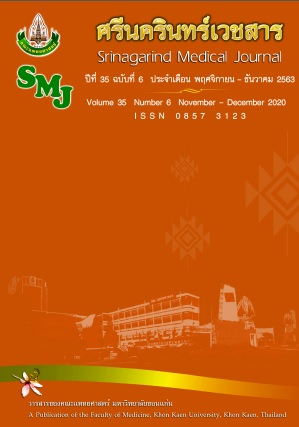Acute angle Closure Glaucoma
Keywords:
angle-closure glaucoma; acute angleclosure glaucoma; ocular emergencyAbstract
Acute angle-closure glaucoma is an ocular emergency that potentially leads to irreversible blindness if the treatment is delayed. The main etiology is the iridotrabecular contact, resulting in anterior chamber angle closure and inadequate drainage of aqueous humor hence the intraocular pressure (IOP) suddenly increases. Risk of angle closure is high among the elderly, women, Asian population and those with hyperopia. Diagnosis relies on history of symptoms resulting from the acute IOP rising and ocular examination demonstrating angle closure with anatomical risk factors. Patients usually present with acute severe painful blurred vision, ciliary injection, seeing rainbow halo around lights, nausea, vomiting and headache. Ocular examination showed high IOP, shallow anterior chamber, anterior lens position, closed anterior chamber angle, and occasionally, optic disc edema. Treatment consists of immediate IOP reduction, control of inflammation and reopen the angle by laser or lens extraction with goniosynechialysis. Serial gonioscopy is considered for the long-term angle monitoring. Trabeculectomy is performed in cases of uncontrolled IOP after reopening of the angle.
References
2. Bourne RRA, Sukudom P, Foster PJ, Tantisevi V, Jitapunkul S, Lee PS, et al. Prevalence of glaucoma in Thailand: a population-based survey in Rom Klao District, Bangkok. Br J Ophthalmol 2003; 87(9): 1069–1074.
3. Foster PJ. The epidemiology of primary angle closure and associated glaucomatous optic neuropathy. Semin Ophthalmol 2002; 17(2): 50–58.
4. Quigley HA, Friedman DS, Congdon NG. Possible mechanisms of primary angle-closure and malignant glaucoma. J Glaucoma 2003; 12(2): 167–180.
5. Tarongoy P, Ho CL, Walton DS. Angle-closure glaucoma: the role of the lens in the pathogenesis, prevention, and treatment. Surv Ophthalmol 2009; 54(2): 211–225.
6. Stefan C, Iliescu DA, Batras M, Timaru CM, De Simone A. Plateau iris – diagnosis and treatment. Rom J Ophthalmol 2015; 59(1): 14–18.
7. Razeghinejad MR, Myers JS. Contemporary approach to the diagnosis and management of primary angle-closure disease. Surv Ophthalmol 2018; 63(6): 754–768.
8. Lan YW, Hsieh JW, Hung PT. Ocular biometry in acute and chronic angle-closure glaucoma. Ophthalmologica 2007; 221(6): 388–394.
9. European glaucoma society. Terminology and guidelines in glaucoma. 4th ed. Savona: EGS; 2014.
10. Wright C, Tawfik MA, Waisbourd M, Katz LJ. Primary angle-closure glaucoma: an update. Acta Ophthalmol 2016; 94(3): 217–225.
11. Sun X, Dai Y, Chen Y, Yu DY, Cringle SJ, Chen J, et al. Primary angle closure glaucoma: what we know and what we don’t know. Prog Retin Eye Res 2017; 57: 26–45.
12. Sakata LM, Lavanya R, Friedman DS, Aung HT, Seah SK, Foster PJ, et al. Assessment of the scleral spur in anterior segment optical coherence tomography images. Arch Ophthalmol 2008; 126(2): 181–185.
13. Chansangpetch S, Rojanapongpun P, Lin SC. Anterior segment imaging for angle closure. Am J Ophthalmol 2018;188:xvi–xxix. doi: 10.1016/j.ajo.2018.01.006.
14. Ramos JLB, Li Y, Huang D. Clinical and research applications of anterior segment optical coherence tomography – a review. Clin Experiment Ophthalmol 2009; 37(1): 81–89.
15. Shabana N, Aquino MCD, See J, Ce Z, Tan AM, Nolan WP, et al. Quantitative evaluation of anterior chamber parameters using anterior segment optical coherence tomography in primary angle closure mechanisms. Clin Experiment Ophthalmol 2012; 40(8): 792–801.
16. Radhakrishnan S. Diagnosing angle closure: gonioscopy vs. OCT [Internet]. Review of ophthalmology; 2019 [cited Sep 20, 2020]. Available from: https://www.reviewofophthalmology.com/article/diagnosing-angle-closure-gonioscopy-vs-oct.
17. Weinreb RN, Friedman DS, editors. WGA consensus series 3: angle closure and angle closure glaucoma. Amsterdam: Kugler; 2006.
18. Khondkaryan A, Francis BA. Angle-closure glaucoma [Internet]. American Academy of Ophthalmology; 2013 [cited Jul 15, 2020]. Available from: https://www.aao.org/munnerlyn-laser-surgery-center/angleclosure-glaucoma-19.
19. Saw SM, Gazzard G, Friedman DS. Interventions for angle-closure glaucoma: an evidence-based update. Ophthalmology 2003; 110(10): 1869–1878.
20. Lim ASM, Tan A, Chew P, Seah S, Min G, Yee T, et al. Laser iridoplasty in the treatment of severe acute angle closure glaucoma. Int Ophthalmol 1993; 17(1): 33–36.
21. Lam DS, Leung DY, Tham CC, Li FC, Kwong YY, Chiu TY, et al. Randomized trial of early phacoemulsification versus peripheral iridotomy to prevent intraocular pressure rise after acute primary angle closure. Ophthalmology 2008; 115(7): 1134-1140.
22. Edwards RS. Behaviour of the fellow eye in acute angle-closure glaucoma. Br J Ophthalmol 1982; 66: 576–579.
23. Lowe RF. The natural history and principles of treatment of primary angle-closure glaucoma. Am J Ophthalmol 1966; 61: 642–51.
24. Wong JS, Chew PT, Alsagoff Z, Poh K. Clinical course and outcome of primary acute angle closure glaucoma in Singapore. Singapore Med J 1997; 38(1): 16–18.
25. Aung T, Ang LP, Chan SP, Chew PTK. Acute primary angle-closure: long-term intraocular pressure outcome in Asian eyes. Am J Ophthalmol 2001; 131(1): 7–12.




